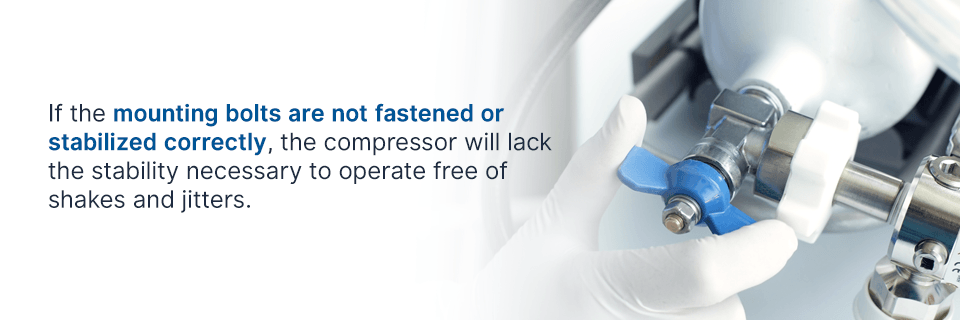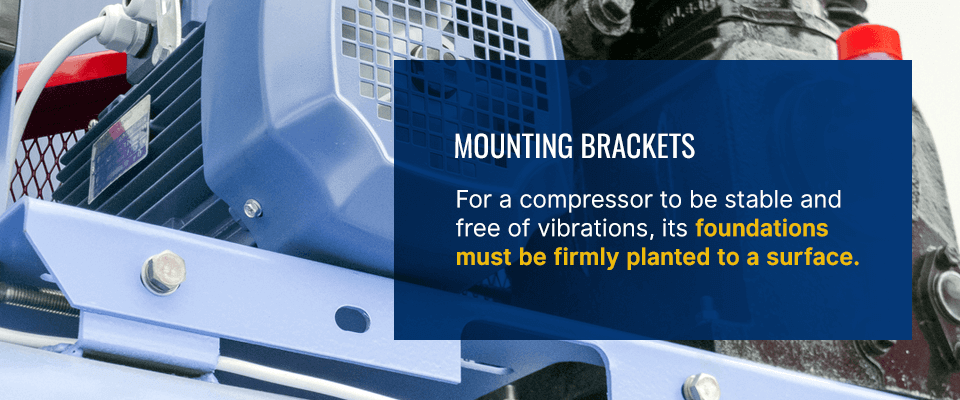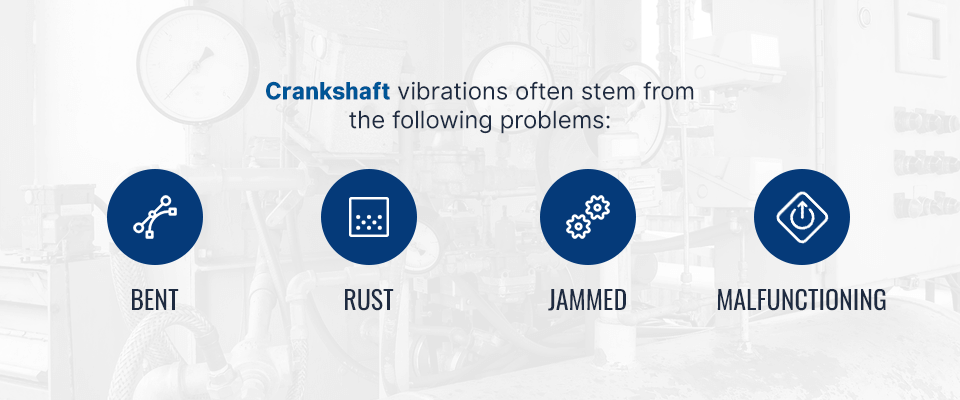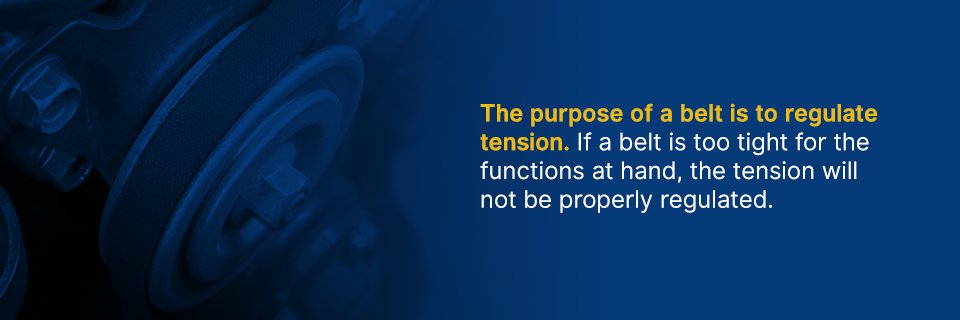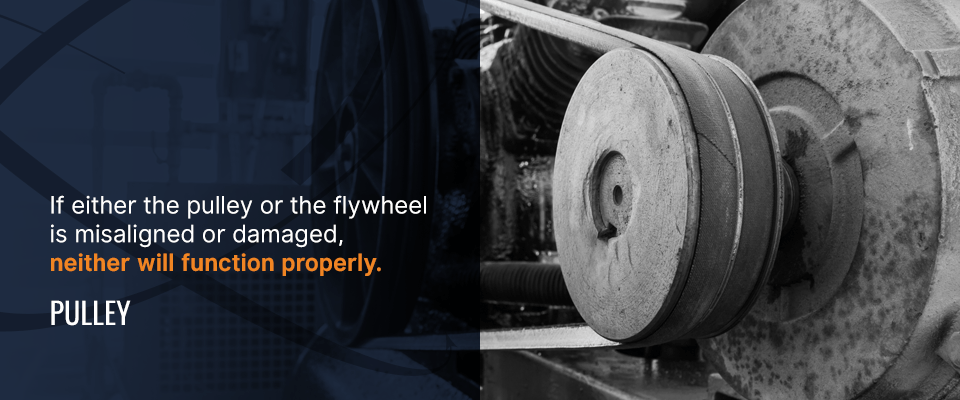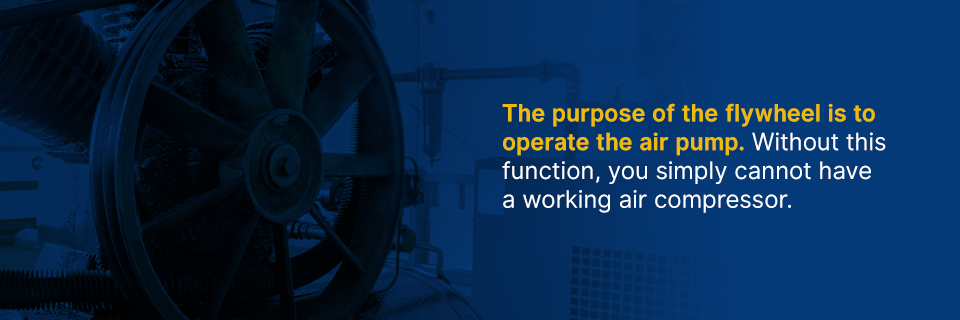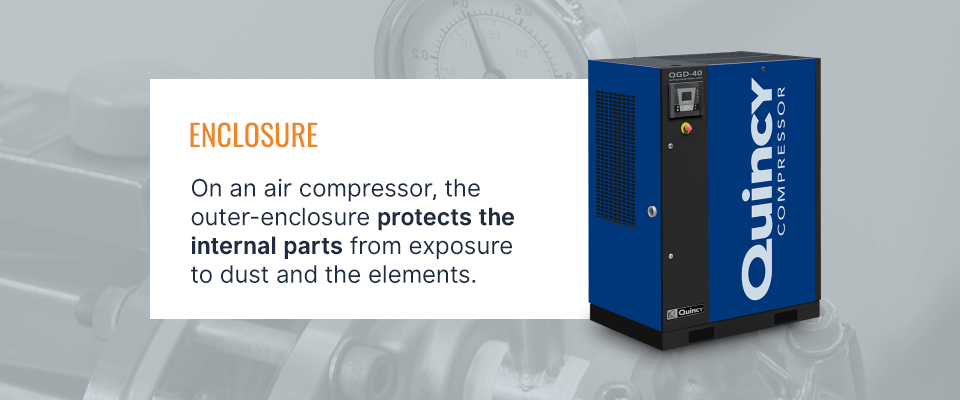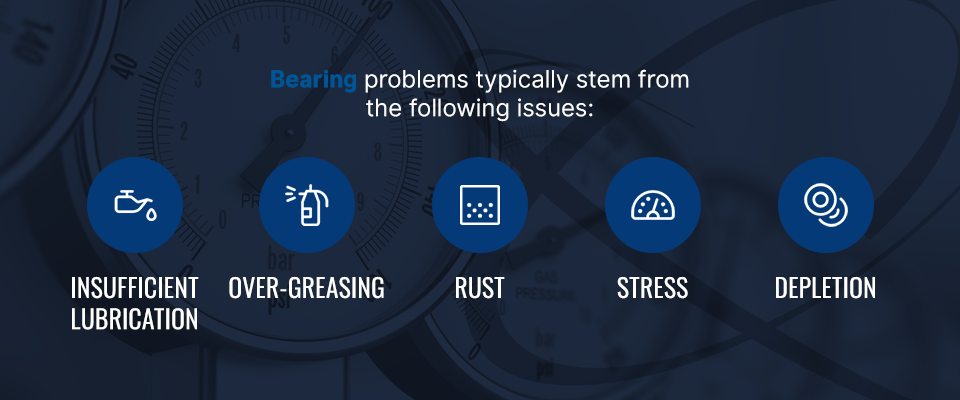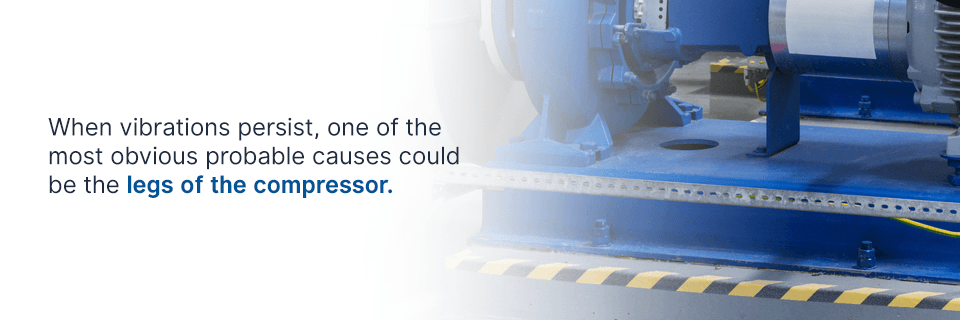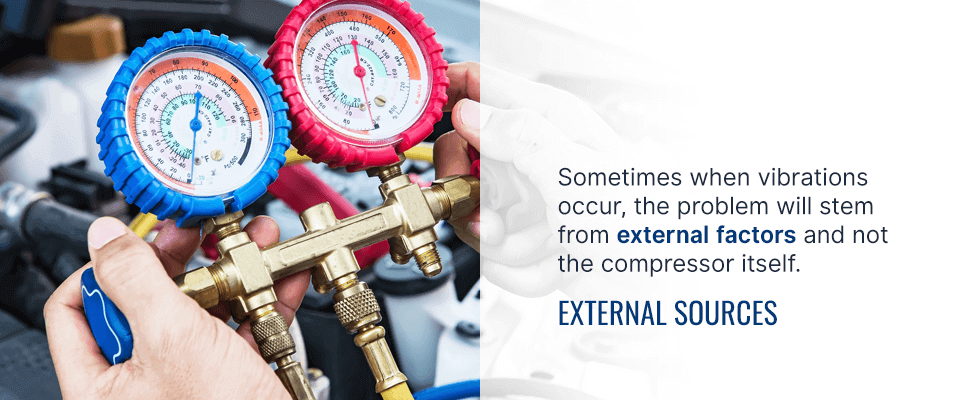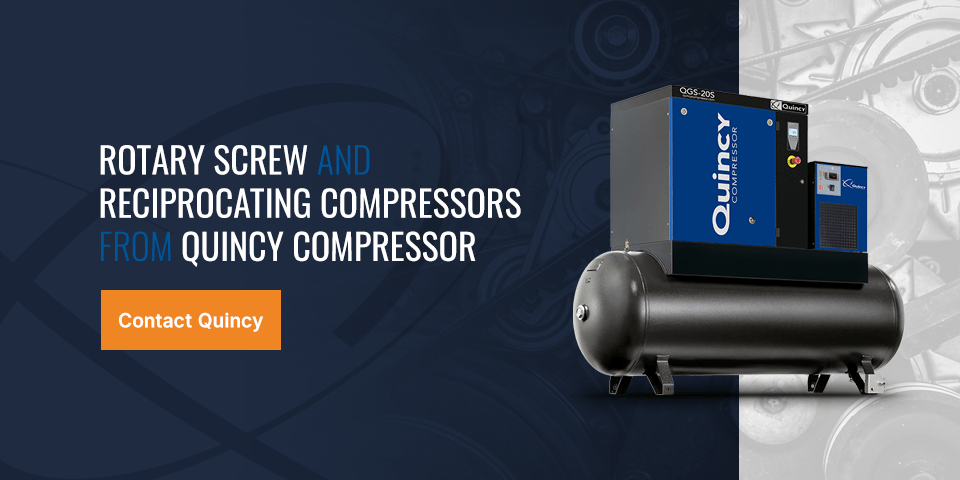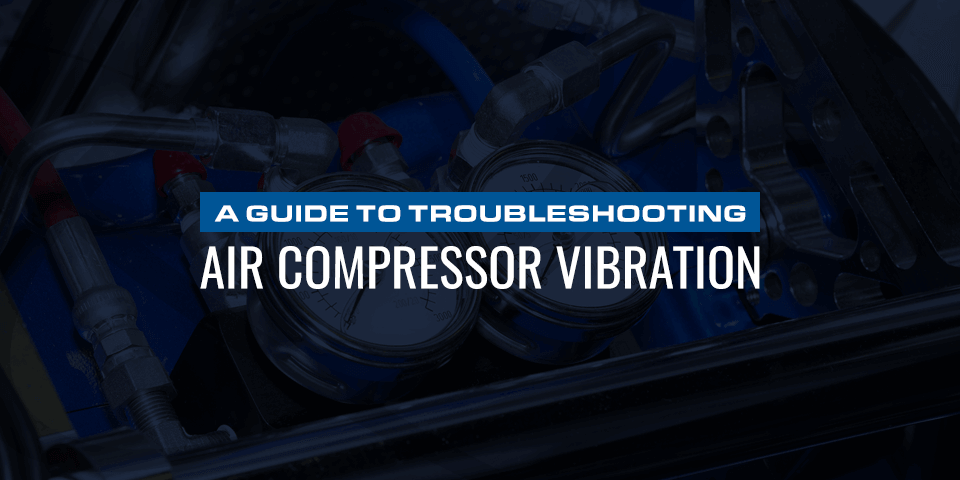
Rotary screw and reciprocating compressor vibration issues can be troubling for many users. Whether you operate in a small workspace or a large industrial setting, it is important to know the cause of vibration in compressors so you can pinpoint the problem when it occurs with your unit. The following compressor vibration troubleshooting guide covers the 10 most common causes of this issue.
Contact Us Learn More Find a Dealer Near You
Common Sources of Air Compressor Vibration and Potential Solutions
The causes of vibration in compressors stem from multiple sources, some internal and others external. To detect the source, you need to perform compressor vibration analysis on a variety of parts and components both inside and outside the machine. Check the following 10 areas for possible sources of vibrations with your air compressor:
1. Mounting Bolts
One of the primary causes of vibration in air compressors is faulty mounting bolts. If the mounting bolts are not fastened or stabilized correctly, the compressor will lack the stability necessary to operate free of shakes and jitters. If your compressor vibrates and you suspect the issue is due to the mounting bolts, check for the following symptoms:
- Loose: If the mounting bolts are loose, they will not offer sufficient support for your air compressor. Consequently, the compressor will vibrate when the cycles are active. Even if only one of the bolts is loose, it could destabilize the overall balance. If the bolts appear loose, tighten or replace as needed.
- Uneven: If the bolts are uneven, the compressor will not have sufficient support, whether you have the machine mounted on the ground or an elevated surface. Check the individual mounts to make sure that they each make firm contact with the underlying surface.
- Misaligned: If the mounting bolts are not properly attached to the compressor, it will not matter whether they are perfectly mounted to the surface because the compressor itself will lack sufficient support. Check to ensure that each bolt is evenly aligned on the compressor.
- Shaky surface: A shaky or trembling surface will cause the compressor to vibrate, especially when it is active. Check that the surface does not shake under pressure. If the compressor is mounted on a table, make sure that each table leg has firm contact with the ground.
- Uneven surface: If the mounting surface is uneven, you will need to move the compressor to a surface that is perfectly level and flat. Inspect the mounting surface for bends or slants and move your compressor to another surface area if necessary.
If you isolate the problem as a mounting issue, the fix could be easier than you initially imagine.
2. Mounting Brackets
For a compressor to be stable and free of vibrations, its foundations must be firmly planted to a surface. Moreover, every part of the compressor must be properly fitted and correctly fastened. If any of these details are overlooked, the compressor could easily vibrate. If you do hear or see vibrations, check for the following issues:
- Too loose: Loose mounting brackets will not give proper support to an air compressor. If the brackets appear loose, double check the mounting attachments and tighten if possible or replace if necessary.
- Poorly fastened: If the mounting brackets are not properly fitted, the issue could be troublesome for the compressor. The lack of support could cause the compressor to shake when active and the situation could get worse as time goes on, resulting in more damage. Check the fasteners to make sure that they are firmly fitted and not loose or ajar.
- Weak support: If the brackets are mounted to an unstable surface, you could have major issues. The compressor needs firm, solid support to function correctly. If the support is weak, move the setup to a sturdy location.
- Rust: If rust develops on the mounting brackets, they will inevitably lose their strength and firm grip. Rust could rapidly spread and cause the brackets to break down. Therefore, rusty mounting brackets should be replaced immediately.
- Worn fasteners: If the fasteners are worn or the threads are stripped, your compressor will not be properly secured by the mounting brackets. This problem would require new fasteners to correct the issue.
Unless your compressor is safely mounted in its location, it should not be used, pure and simple.
3. Crankshaft
In a reciprocating air compressor, ambient air is drawn into the compression chamber with a crankshaft. If problems exist with the crankshaft, the compressor is liable to display various performance issues, including vibrations. Crankshaft vibrations often stem from the following problems:
- Bent: If the crankshaft is bent, it will not function correctly. A crankshaft could be ajar due to constant stresses within the compressor. If you suspect the issue is rooted in the crankshaft, you will need to remove the encasement and check to see if the crankshaft is, in fact, bent.
- Rust: When metal parts become rusty, they simply do not work as well as intended. Rust causes brittleness, dullness and weakness in metal parts, all of which are bad for parts that are put in place for vital mechanical functions. If your crankshaft is rusty, you will need to switch it out for a new one.
- Jammed: A jammed component could be troublesome for the internal mechanisms of an air compressor, especially if the part in question is as crucial as the crankshaft. If the crankshaft is jammed at one end or the other, consult your owner’s manual for a photo of the proper alignment. Unless you are skilled at compressor maintenance, this problem may require professional assistance.
- Malfunctioning: If the crankshaft fails to work in any way, the problem could manifest in numerous strange behaviors, including vibrations. Whether the crankshaft moves too fast, too slow or inconsistently, you will probably need to have it replaced.
Crankshaft problems can be daunting, but they can easily be fixed if you correctly identify the issue.
4. Belts
Belts are among of the most crucial pieces in an air compressor. Each belt is in its place to regulate the tension and speed of corresponding parts that move inside a compressor’s motor. If the internal tensions are not properly regulated, the compressor could vibrate as a result. Problems with compressor belts are typically rooted in the following issues:
- Over-tightness: The purpose of a belt is to regulate tension. If a belt is too tight for the functions at hand, the tension will not be properly regulated. Consequently, the compressor might vibrate due to over-stiffness in the motor functions. If a belt is too tight, it is probably a bit too short for the parts in question.
- Looseness: In much the same way that over-tightness could be an issue, a loose belt also will not regulate the speed and tension of the corresponding parts. In some cases, belts become stretched and lose their elasticity. With a loose belt, you could have parts that move too fast or waywardly, causing the compressor to vibrate, in which case you would need a tighter belt.
- Dullness: A belt must retain its rubbery character to have sufficient elasticity. If a belt becomes dull and hardened, it could lose its ability to regulate the speed and tension of the corresponding internal parts. Check the tension on your compressor belts to see whether any of them feel too stiff to work correctly.
- Cracks: Belts can slowly crack once the rubber becomes dull and stiff. If you notice any cracks on a belt, replace the belt immediately. A cracked belt could easily snap at any time, causing numerous other performance issues.
- Snaps: If a belt has already snapped, the compressor is likely to vibrate more loudly and violently. If you notice such symptoms, turn off the compressor immediately and check the internal components. If you see a snapped belt, you will have pinpointed the primary problem.
Fortunately, belt issues are among the easiest symptoms to remedy in an air compressor.
5. Pulley
The pulley and flywheel in an air compressor are interdependent on one another. If either the pulley or the flywheel is misaligned or damaged, neither will function properly. Consequently, the air compressor might vibrate due to the pulley/flywheel issue. When you inspect the pulley, check for the following danger signs:
- Too loose: If the pulley is too loose, it cannot correctly regulate the motions of the flywheel. To see whether looseness is the issue, pull on the pulley to see whether it expands too easily. If it seems on the verge of slipping off, replace it with a firmer pulley.
- Too tight: If the pulley is too tight, it will inevitably restrict the flywheel from moving at the right speed. The extreme tension that this would cause could easily make the compressor vibrate. Pull on the pulley to see whether it has sufficient elasticity.
- Stiff: In some cases, the pulley will be the right size, yet the rubber will have lost any elasticity. When you feel the pulley, check to see whether it feels rubbery or hard and replace it if necessary.
- Cracked: As with cracked belts, cracked pulleys are very troubling for air compressors. If you notice cracks in the pulley, it could only be a matter of time before it snaps entirely, causing the pulley element to fail. If you see any cracks, replace the pulley immediately.
- Broken: Once a pulley breaks, the flywheel will not be able to function correctly. A compressor cannot operate until you have this issue fixed.
As with broken belts, pulley problems are relatively easy to identify and remedy.
6. Flywheel
The purpose of the flywheel is to operate the air pump. Without this function, you simply cannot have a working air compressor. Unfortunately, flywheels can develop problems over time and vibrations are among the noticeable side effects. A loose flywheel could also cause excessive noise inside a compressor. When you inspect the flywheel, check for the following issues:
- Misalignment: If the flywheel is not properly attached, it could easily exhibit rotational problems. A flywheel might become misaligned after many years of intense use, in which case you will need to check the owner’s manual for an indication of how the attachment should look and either fix the issue or replace the flywheel.
- Looseness: A loose flywheel could spell disaster for your air compressor. If you catch the problem when it is only beginning, you could remedy the issue and avoid further costly issues. As you inspect the flywheel, feel for any looseness. Do you notice any perpendicular rattling when you pull on the flywheel? If so, tighten or replace the part.
- Rust: If rust forms on the flywheel, it will gradually lose its ability to function as intended. Rust can spread like weeds on metal components, so any rust that develops on your flywheel could spread to the fasteners and adjoining parts. If you notice rust on the flywheel, replace the part immediately.
- Poor fastening: If the fasteners that keep the flywheel in place are loose or ajar, the flywheel might wobble or strain when pumping air into the pressurization chamber, causing the compressor to vibrate. If tightening does not work, you will probably need a new flywheel.
- Ill-fitted: If the flywheel in your compressor is a replacement part, it might not have been the right choice for your make and model. Check the user’s manual for information on the right flywheel and replace if necessary.
Flywheel issues can be confusing and problematic, but your compressor could work like new once you have the cause fixed.
7. Enclosure
On an air compressor, the outer-enclosure protects the internal parts from exposure to dust and the elements. Therefore, the enclosure is supposed to fit the frame of your compressor firmly and snugly. If the fit is off, the compressor is liable to vibrate when active. Check for the following problems as you inspect the enclosure:
- Loose fasteners: When an enclosure is loose, the issue is usually due to a loose set of fasteners. To see whether this is the case, press against the connecting points of the enclosure. If there is any nudging, tighten the fasteners.
- Misaligned panels: For an enclosure to fit your compressor correctly, the panels must align to the corresponding framework. Make sure that each panel is properly attached on all corners. If the enclosure panels on your compressor were replaced at any time, the fitting might be off.
- Bent panels: If the compressor has incurred blunt force at any time, the panels could have been dented on impact. This can set the enclosure slightly ajar, causing fasteners to unhinge at certain corners. Check for bends and looseness and replace if necessary.
- Rust: If enclosure panels become rusty, the growth could eat away at their integrity. Rust can cause the metal to become brittle and weak. If the problem advances, the enclosure might not fit properly. If the enclosure on your air compressor is rusty, replace it immediately.
- Poor placement: The enclosure could be in perfect shape but poorly attached to the compressor. If the enclosure was not fully situated before fastening, some of the screws may have been applied at awkward angles, setting the alignment ajar. Check for this problem and reattach if necessary.
A loose enclosure could easily cause a compressor to vibrate and even rattle, but the problem is easy to fix when identified correctly.
8. Bearings
Bearings allow rollers to turn inside of an air compressor. If the bearings are inhibited in any way, this could spell trouble for the rolling parts and negatively impact the compressor as a whole. Two notable side effects of this problem are bearing noise and vibrations. Bearing problems typically stem from the following issues:
- Insufficient lubrication: Bearings need lubrication to roll properly and avoid surface friction. If the bearings are not lubricated, friction could occur between the bearings and the inner-rollers, causing rust to form on the various metals. To avoid these problems, lubricate your bearings periodically.
- Over-greasing: Even though bearings require lubrication, problems can occur if too much grease is applied. An over-greased set of bearings could inhibit movement, causing further issues with the compressor’s mechanisms.
- Rust: The effects of rust can be disastrous in a set of roller bearings due to the constant movement. Rust that forms on one bearing can spread like dominoes to other bearings and also affect the roller interior. If this happens, the bearings and roller should be replaced.
- Stress: If the rollers have endured stress due to problems with corresponding components in the compressor, the bearings could easily suffer.
- Depletion: If a roller does not have enough bearings, it will likely strain to do its job correctly. This could have an ill-effect on the compressor’s functions, cause the machine to rattle when active.
Compressors consist of various rolling and turning parts, of which bearings are among the most important.
9. Legs
When vibrations persist, one of the most obvious probable causes could be the legs of the compressor. If your compressor sits on four legs, you could easily have an issue if one or more of the legs does not make firm, even contact with the underlying surface. Inspect the compressor legs for the following possible symptoms:
- Unevenness: As with tables and chairs, compressor legs must be perfectly even to do their job properly. If one leg is slightly loose, ajar or uneven with the others, adjust that leg or replace it if necessary.
- Bent: If any of the legs on your compressor are bent or somehow crooked, you will need to replace them. Generally, when you replace one leg, you should replace them all just to make sure that the legs are perfectly even with one another.
- Unsupported: In some cases, the legs might wobble because of an uneven surface. This could be obvious with a portable machine that only vibrates when you set it on a tabletop. Make sure that whatever surface you use is perfectly flat, firm and secure.
- Damaged: If the legs of your compressor are in any way damaged, they should be replaced immediately. Legs serve an essential function by elevating the compressor body, which is not intended to have direct contact with the ground. Therefore, any damage to the legs is as serious as damage to the belts, pulleys or bearings.
- Rust: If the legs are rusty, they will eventually start to give way. Once rust takes hold, you should replace the affected part before the problem spreads to adjoining metals, or you could face more costly issues in the months ahead.
To avoid vibrations, make sure that your air compressor has a firm and even set of legs to stand on.
10. External Sources
Sometimes when vibrations occur, the problem will stem from external factors and not the compressor itself. If your air compressor vibrates despite a fitted enclosure, an even set of legs and a perfect set of internal parts, the motion might originate from one of the following:
- Neighboring machines: If your air compressor is situated next to other equipment that vibrates, that could be the source of the problem. When the neighboring machine vibrates, that sets off tremors that cause the compressor to vibrate as well. This would be the most probable cause if both machines are situated on a tabletop.
- Attached components: Any piece that moves can send tremors through anything attached. Therefore, if your air compressor is attached to other equipment or pneumatic devices that tremor, the jitters could easily be felt by the compressor itself.
- Unstable surface: An air compressor must be situated on a solid, even surface, pure and simple. If the surface is in any way bent, crooked or uneven, the compressor will lack the stability to function without vibrating, even if the legs are even.
- Shaky ground: If external factors cause the ground to shake, your air compressor will shake as well. If, for example, you have the compressor placed on a wooden floor that creaks, there will likely be subtle tremors that will cause the machine to vibrate.
Even the healthiest and most robust air compressors will not be free of vibrations unless you keep the unit at a safe distance from surfaces or objects that vibrate.
Rotary Screw and Reciprocating Compressors From Quincy Compressor
A vibrating compressor can sometimes be fixed, but sometimes these jitters simply mean that the time has come to replace your unit with a newer and better model. At Quincy Compressor, we have offered reliable service and quality parts as well as the best rotary screw and reciprocating compressors to everyone from independent users to companies of all sizes across the commercial and industrial sectors. Contact Quincy or find a dealer near you to learn more about our selection.


